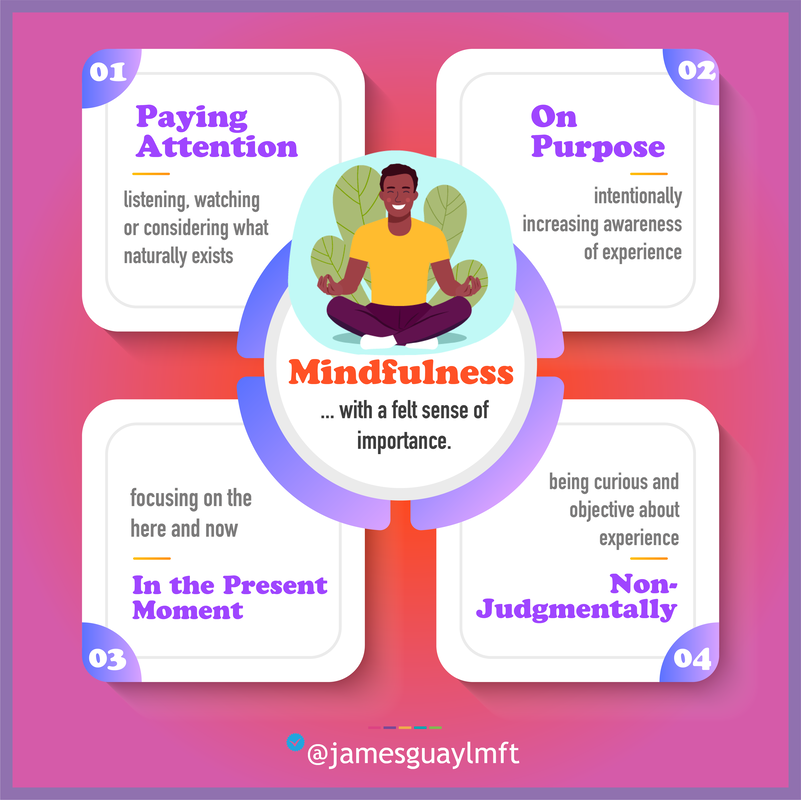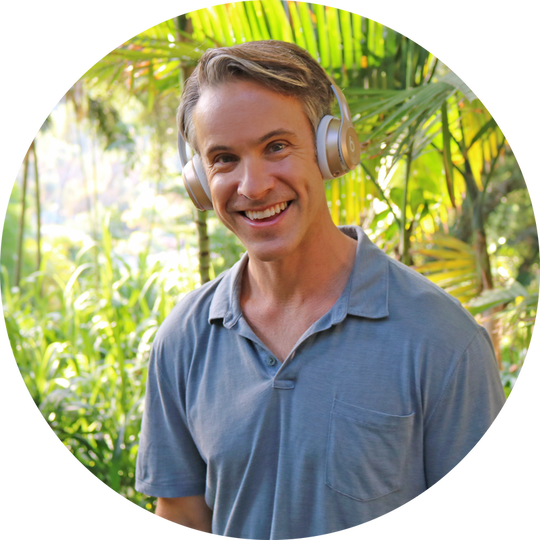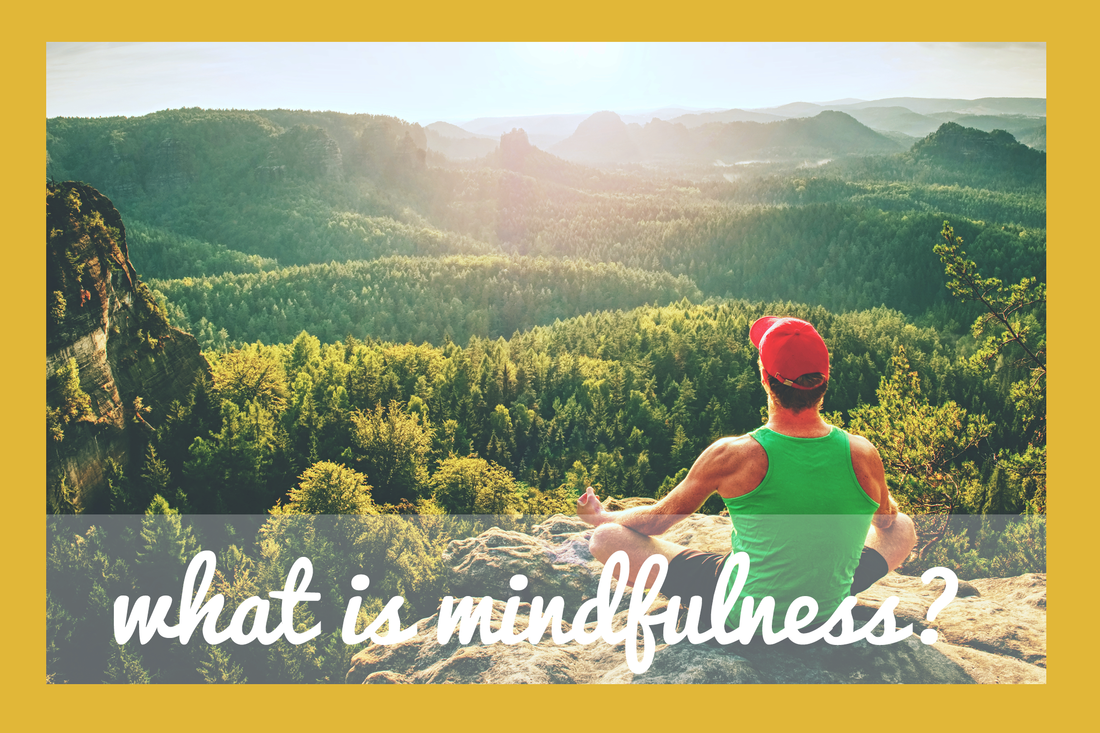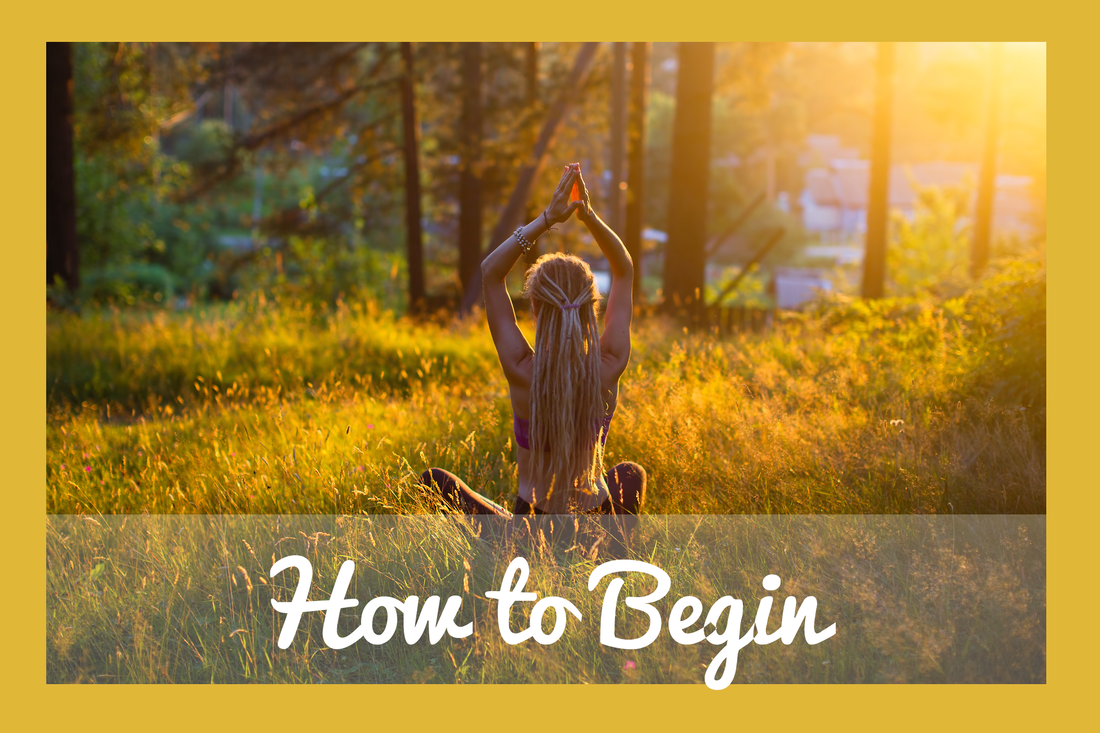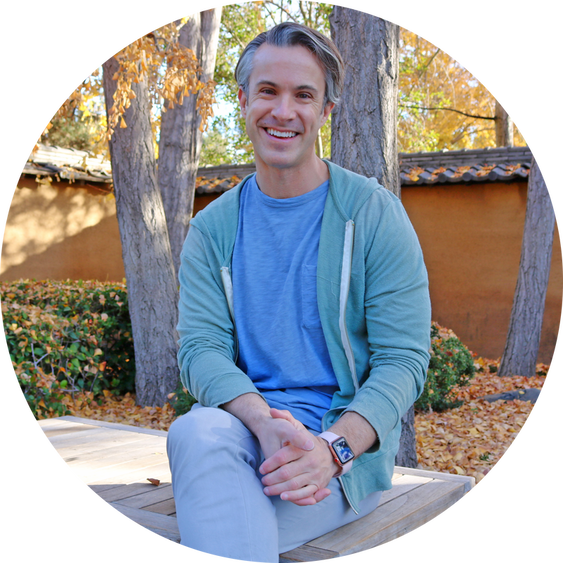Mindfulness Online Therapy
Mindfulness with Compassion
What is mindfulness and how do we actually use it? It’s a topic that’s near and dear to my heart because I’ve seen how powerful it changes the lives of my clients and certainly has my own as well. Today I’ll be defining mindfulness and describing how it can be used to reduce stress
What is Mindfulness?
Mindfulness is being aware in the present moment, with curiosity, not judgement.
Mindfulness Described
It’s kind of like an unfiltered mirror that shows us EXACTLY what’s going on AS it’s going on, IN the here and now and most importantly WITHOUT all the noise and judgements that we so often have. When we slow down and observe whatever’s happening NOW, from a place of neutrality, objectivity or even compassion, then we can see more clearly what’s going on and respond differently to our environment. When we’re being mindful, we can feel a greater sense of freedom to engage with whatever’s happening from a more authentic place.
Thankfully, a natural byproduct of mindfulness is that we’re more kind and more compassionate with ourselves and with others...something that is SORELY missing in today’s political climate.
Thankfully, a natural byproduct of mindfulness is that we’re more kind and more compassionate with ourselves and with others...something that is SORELY missing in today’s political climate.
| What Is Mindfulness.pdf | |
| File Size: | 658 kb |
| File Type: | |
Podcast Series: Mindfulness
If you prefer listening to a podcast at your convenience, then check out my podcast series on this topic, in short bite-sized episodes.
Using Mindfulness to Reduce Stress
A frequent complaint I hear about AND certainly experience myself at times, is the EVER increasing volume of work and obligations we have in our job, and the increasing stress that comes with that.
So let’s imagine that you’re in the thick of things, mid-day, and you’re just freaking out — you have a deadline at the end of your work day and you feel way behind where you were hoping to be.
Instead of going on auto-pilot — maybe working too fast and missing things, or the reverse, where you’re procrastinating or completely immobilized — we might, instead, take 5 minutes to practice mindfulness...to recalibrate.
1. BEGIN: How We Hold Stress Physically
A helpful place to start being mindful when we’re anxious is first to just notice what’s happening in our body as it is right now, without necessarily trying to change anything about it. Are we holding tension in our shoulders or neck? Do we feel sick to our stomach from the stress? Do we have restricted shallow breathing? A lot of us hold anxiety in various parts of our body. BEING mindful, we allow space for whatever it is that we discover, without the judgements of what’s right or what’s wrong...simply observing from a place of curiosity where things are at.
2. TRANSFORM STRESS: Attending to Physical Symptoms
Once we’ve observed what’s going on for us physically, to reduce stress we can begin to attend to what we find in a caring way. Maybe we decide to take a deeper breath, relax our shoulders, or get into a more comfortable posture. Maybe we notice we need some food to fuel and sustain our energy.
We may notice that the intensity of our stress changes as we respond. As we attend to this mindfully, we can lean into whatever natural spontaneous reaction is happening, without overindulging in it AND without ignoring or denying it exists. We simply pay attention non-judgmentally and we learn how we hold anxiety. With practice we can learn how to self-regulate our stress so that we’re having enough of this alert energy to perform at our best, without it derailing us in the process.
So let’s imagine that you’re in the thick of things, mid-day, and you’re just freaking out — you have a deadline at the end of your work day and you feel way behind where you were hoping to be.
Instead of going on auto-pilot — maybe working too fast and missing things, or the reverse, where you’re procrastinating or completely immobilized — we might, instead, take 5 minutes to practice mindfulness...to recalibrate.
1. BEGIN: How We Hold Stress Physically
A helpful place to start being mindful when we’re anxious is first to just notice what’s happening in our body as it is right now, without necessarily trying to change anything about it. Are we holding tension in our shoulders or neck? Do we feel sick to our stomach from the stress? Do we have restricted shallow breathing? A lot of us hold anxiety in various parts of our body. BEING mindful, we allow space for whatever it is that we discover, without the judgements of what’s right or what’s wrong...simply observing from a place of curiosity where things are at.
2. TRANSFORM STRESS: Attending to Physical Symptoms
Once we’ve observed what’s going on for us physically, to reduce stress we can begin to attend to what we find in a caring way. Maybe we decide to take a deeper breath, relax our shoulders, or get into a more comfortable posture. Maybe we notice we need some food to fuel and sustain our energy.
We may notice that the intensity of our stress changes as we respond. As we attend to this mindfully, we can lean into whatever natural spontaneous reaction is happening, without overindulging in it AND without ignoring or denying it exists. We simply pay attention non-judgmentally and we learn how we hold anxiety. With practice we can learn how to self-regulate our stress so that we’re having enough of this alert energy to perform at our best, without it derailing us in the process.
Your true home is in the here and the now
— Thích Nhất Hạnh
3. BEGIN: Notice Thoughts & Feelings Related to Anxiety
Next, using mindfulness to reduce stress, it’s useful to observe our thoughts and feelings in the present moment, again...nonjudgmentally. We notice whatever is there from a place of curiosity, which naturally gives us more space to see what’s going on and how we’re making meaning of it all.
In this example, we may notice a feeling of fear when we imagine not meeting our deadline. As we observe and feel this fear in a more neutral way, it may connect to a thought — a memory of when we were invalidated or even shamed for not performing at our best.
As we recall this memory, and all the feelings that are associated with it, we may notice that we unconsciously or otherwise, created a defense mechanism to protect us from re-experiencing that kind of pain and discomfort. Maybe we came to believe that in order to be liked, valued or attended to we needed to be perfect. We learned to set very high and often unattainable expectations of ourselves to avoid shame and to get our needs met. With mindfulness we may come face-to-face with our own perfectionism, something that fuels our anxiety and feeling of being overwhelmed.
4. TRANSFORM STRESS: Attend to Perfectionism
As we get to know this defense, it’s important not to judge ourselves for it. We can so easily get stuck in a loop, of judging the judgements of our judgements. At some point, we need to step back and notice how this is just pouring salt on a gaping long-standing wound. Instead we can recognize how it benefited us along with how it limits us. Both are important to recognize...separating out the facts from the judgements.
As a therapist, I’m continually amazed at the brilliance of our defense mechanisms and ways that we try to protect ourselves AND get other needs met. And we can also recognize when they no longer serve us or when we apply them too much of the time when they’re not as useful.
With mindfulness we can increase our awareness of what our stress is connected to...in this example the desire to be valued...to be loved...and the self-limiting beliefs that come along with it...our own perfectionism.
Once we notice the noise of our thoughts, feelings, memories and self-limiting beliefs, we can then treat ourselves like we would a best friend when THEY’RE feeling down or insecure.
We can better find a place of “good enough” or even “excellence” but NOT “perfection”. We can make mistakes and learn from them. When we recognize and really FEEL our inherent worth and value, we’re less reactive and more responsive to the tasks ahead.
We’re now more able to have a moderate amount of stress that can give us the energy to work at our best to meet our deadline.
Mindfulness is a way of befriending ourselves and our experience
— Jon Kabat-Zinn
— Jon Kabat-Zinn
Using Mindfulness to Treat Yoyo Dieting
I’m gonna use the example of yoyo dieting, wanting to lose or gain weight, as it’s something most of us can relate to at one time or another in our lives. There’s so much societal pressure to lose/gain weight, get fit, have ripped abs or some other body ideal. It’s challenging to have a good body image in this day and age.
It’s very easy to go drastic, and in ways that are not so healthy. We may find ourselves in a habitual pattern of searching for the next best diet regime, doing it for a period of time, losing dramatic weight but then finding ourselves unable to sustain it...because ultimately it’s probably not very healthy for our bodies and our mind in the first place.
A natural byproduct of being too rigid, too perfectionistic or too limiting with anything — let alone our food intake — is that we often swing to the opposite extreme and then feel completely out-of-control.
So...what’s the antidote to yoyo dieting? Using the tool of mindfulness, we can get to know our self-destructive habits, where they come from, and learn to be kinder and more compassionate with ourselves, like we would a best friend.
So let me take you through what this might look like.
It’s very easy to go drastic, and in ways that are not so healthy. We may find ourselves in a habitual pattern of searching for the next best diet regime, doing it for a period of time, losing dramatic weight but then finding ourselves unable to sustain it...because ultimately it’s probably not very healthy for our bodies and our mind in the first place.
A natural byproduct of being too rigid, too perfectionistic or too limiting with anything — let alone our food intake — is that we often swing to the opposite extreme and then feel completely out-of-control.
So...what’s the antidote to yoyo dieting? Using the tool of mindfulness, we can get to know our self-destructive habits, where they come from, and learn to be kinder and more compassionate with ourselves, like we would a best friend.
So let me take you through what this might look like.
Hakomi
Being Mindful of External Messages
Imagine for a moment, circles within a circle, and the outer circle being our external environment while the inner circle represents our inner life. When it comes to yoyo dieting, I find it useful to start from the outer external environment.
While mindfulness is rooted in the present moment, it’s sometimes helpful to look at our past in order to better understand where our current thoughts, feelings, physical sensations and behaviors around dieting come from. This isn’t about getting stuck in past resentments or regrets but rather about having a deeper awareness of how we got here. This can help us have a greater felt sense of choice IN THE PRESENT MOMENT.
From a place of mindfulness, ask yourself some questions about your PAST INFLUENCES:
* Why do you believe you should lose/gain weight?
* What messages did you receive about your body’s weight, shape or size growing up?
* What messages did you hear from your family of origin, peers, the media and society at large?
* What actual experiences have you had where you started to believe that a certain body shape/size would get you more attention, love or validation?
* Did you get teased for not being society's ideal weight?
* Did you get shamed by a medical provider?
* How often have you heard or told fat jokes?
Let’s recognize that the US weight loss market, at the time of this recording, is now worth 66 billion dollars….a record number, so we see dieting fads marketed ALL the time.
Instead of just analyzing these things from an intellectual perspective, using mindfulness allows us to connect the dots from our past experiences to how we formed our current beliefs.
Also, mindfulness allows us to pay attention to how our current environment impacts our yoyo dieting and poor body image.
From a place of mindfulness, ask yourself some questions about your CURRENT ENVIRONMENT:
Take some time to notice how you digest images, and what assumptions you make about people or yourself based on these images. This leads us to the inner circles of influence.
While mindfulness is rooted in the present moment, it’s sometimes helpful to look at our past in order to better understand where our current thoughts, feelings, physical sensations and behaviors around dieting come from. This isn’t about getting stuck in past resentments or regrets but rather about having a deeper awareness of how we got here. This can help us have a greater felt sense of choice IN THE PRESENT MOMENT.
From a place of mindfulness, ask yourself some questions about your PAST INFLUENCES:
* Why do you believe you should lose/gain weight?
* What messages did you receive about your body’s weight, shape or size growing up?
* What messages did you hear from your family of origin, peers, the media and society at large?
* What actual experiences have you had where you started to believe that a certain body shape/size would get you more attention, love or validation?
* Did you get teased for not being society's ideal weight?
* Did you get shamed by a medical provider?
* How often have you heard or told fat jokes?
Let’s recognize that the US weight loss market, at the time of this recording, is now worth 66 billion dollars….a record number, so we see dieting fads marketed ALL the time.
Instead of just analyzing these things from an intellectual perspective, using mindfulness allows us to connect the dots from our past experiences to how we formed our current beliefs.
Also, mindfulness allows us to pay attention to how our current environment impacts our yoyo dieting and poor body image.
From a place of mindfulness, ask yourself some questions about your CURRENT ENVIRONMENT:
- What magazines, TV shows and other media do you currently consume?
- What social media accounts do you follow and how do they impact you?
- How does your behavior on dating or hookup apps influence your body image?
- What messages do you hear currently about dieting from friends, family and co-workers?
Take some time to notice how you digest images, and what assumptions you make about people or yourself based on these images. This leads us to the inner circles of influence.
Nothing ever goes away until it has taught us what we need to know
— Pema Chödrön
— Pema Chödrön
Being Mindful of Internal Messages
Next, it’s helpful to be mindful of our internal landscape. Being mindful, we take ourselves off auto-pilot, and notice what’s going on inside, using our physical sensations as a guide. If our thoughts/beliefs influence our feelings influence our behaviors (like yoyo dieting), then let’s start with our thoughts.
Thoughts/Beliefs:
Having just acknowledge all of the diet/body-related memories, external messages and how they’ve formed our self-limiting beliefs what happens in your physical body? Notice the areas of tension/contraction, maybe numbness or disconnection, whatever is there, just allow it to be for right now.
What happens inside when you compare yourself to someone else, and judge yourself or others accordingly? If you observe a belief that you can only be worthy, loved or noticed if you look a certain way, notice how this shows up in your body. Is there any jitteriness, paralysis or jumping-out-of-your-body like sensations that manifests in your body? Maybe shallow breathing or holding tension in your digestive area? Again, it’s important to watch this things with curiosity and without judgment.
Feelings:
Next, notice any associated feelings. Do you feel fear, hurt, anger, apprehension, desperation or anything else as it relates to yoyo dieting or your body image? Observe these feelings without having to DO anything about them just yet. First we need to know what’s going on before we can treat them.
Behaviors:
Give yourself some time to recognize your behaviors too. What are your patterns with yoyo dieting? How long do you sustain certain diets and what percentage of the time are you in alignment with your goals? Again, this is simple taking a measurement of where you’re currently at and your typical patterns, not analyzing things from a place of judgment. So if you start judging yourself, notice that from a greater place of neutrality.
Thoughts/Beliefs:
Having just acknowledge all of the diet/body-related memories, external messages and how they’ve formed our self-limiting beliefs what happens in your physical body? Notice the areas of tension/contraction, maybe numbness or disconnection, whatever is there, just allow it to be for right now.
What happens inside when you compare yourself to someone else, and judge yourself or others accordingly? If you observe a belief that you can only be worthy, loved or noticed if you look a certain way, notice how this shows up in your body. Is there any jitteriness, paralysis or jumping-out-of-your-body like sensations that manifests in your body? Maybe shallow breathing or holding tension in your digestive area? Again, it’s important to watch this things with curiosity and without judgment.
Feelings:
Next, notice any associated feelings. Do you feel fear, hurt, anger, apprehension, desperation or anything else as it relates to yoyo dieting or your body image? Observe these feelings without having to DO anything about them just yet. First we need to know what’s going on before we can treat them.
Behaviors:
Give yourself some time to recognize your behaviors too. What are your patterns with yoyo dieting? How long do you sustain certain diets and what percentage of the time are you in alignment with your goals? Again, this is simple taking a measurement of where you’re currently at and your typical patterns, not analyzing things from a place of judgment. So if you start judging yourself, notice that from a greater place of neutrality.
Be Compassionate Toward Your Body
The third step to working with yoyo dieting is to be compassionate and caring of your body, soul and mind. Whatever you discover, hold it with curiosity and kindness. When we’re compassionate with ourselves, we can take responsibility for how we’ve treated ourselves and others and do it differently. When we beat ourselves up, we’re more likely to repeat vicious cycles of abuse.
Feed your body, mind and soul from a place of love and kindness. Notice when your body is hungry AND when it’s full. Eating slow enough and mindfully we can reorient the body to these cues.
Instead of labeling certain foods good or bad, notice how each kind of food can have a different impact on your body and adjust accordingly, from a place of care not dogma. Give yourself time to develop a taste for foods that have a higher nutrient value, usually foods that have a more direct relationship with the sun, the source of energy. This isn’t about being perfect, whatever that means for nutrition, just making sure you’re getting enough whole foods to help your body function well, heal, and have a good immune response.
Compassion in this area is about having good enough nutrition, exercise and sleep - to have a holistic perspective of what your body needs, not a number on a scale or a certain shape/size.
Feed your body, mind and soul from a place of love and kindness. Notice when your body is hungry AND when it’s full. Eating slow enough and mindfully we can reorient the body to these cues.
Instead of labeling certain foods good or bad, notice how each kind of food can have a different impact on your body and adjust accordingly, from a place of care not dogma. Give yourself time to develop a taste for foods that have a higher nutrient value, usually foods that have a more direct relationship with the sun, the source of energy. This isn’t about being perfect, whatever that means for nutrition, just making sure you’re getting enough whole foods to help your body function well, heal, and have a good immune response.
Compassion in this area is about having good enough nutrition, exercise and sleep - to have a holistic perspective of what your body needs, not a number on a scale or a certain shape/size.
Kindness gives birth to kindness
— Pema Chödrön
— Pema Chödrön
It is never too late to turn on the light
– Sharon Salzberg
Using Mindfulness to Improve Communication
A helpful acronym, RAIN, can be used to deepen your understanding of yourself and another person.
“R” stands for RECOGNIZE, “A” is about ALLOWING for whatever is happening to happen, “I” is about INVESTIGATING what’s going on with kindness and “N” stands for NON-IDENTIFICATION, or not getting hooked by our stories/histories and limited interpretations of what’s transpired.
RAIN:
RECOGNIZE what’s happening:
ALLOW it to be just what it is:
INVESTIGATE with kindness:
NON-IDENTIFICATION by resting in natural awareness OR NOURISH with self-compassion:
“R” stands for RECOGNIZE, “A” is about ALLOWING for whatever is happening to happen, “I” is about INVESTIGATING what’s going on with kindness and “N” stands for NON-IDENTIFICATION, or not getting hooked by our stories/histories and limited interpretations of what’s transpired.
RAIN:
RECOGNIZE what’s happening:
- Status/health of your relationship (healthy, critical, alive, bored, toxic?)
- How earliest relationships with caregivers affect your relational patterns
- Communication patterns: how assert needs, how vulnerable, how resolve conflict, blaming vs taking responsibility
ALLOW it to be just what it is:
- Notice the thoughts, feelings, sensations, behaviors, beliefs to be just what they are
- Gives space for us to see things we perpetually project onto others, disown, self-medicate or deny
INVESTIGATE with kindness:
- Where patterns come from? BE curious.
- Why communicate in ways that you do? (to be heard, cared for, to stand up for, to advocate for self, etc.)
NON-IDENTIFICATION by resting in natural awareness OR NOURISH with self-compassion:
- To not over-identify with limited sense of self, feelings, thoughts or stories
